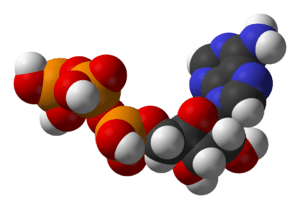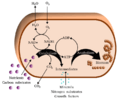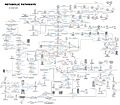Metabolism facts for kids

Metabolism is all the amazing chemical reactions that happen inside living things to keep them alive. These reactions take place in the tiny cells that make up every organism, from the smallest bacteria to the largest animals.
These reactions are helped by special helpers called enzymes. Enzymes make sure the reactions happen quickly and correctly. Metabolism allows organisms to grow, make new organisms (reproduce), keep their bodies working, and react to what's around them. The word 'metabolism' also includes how food is digested and how important substances move around inside and between cells.
Contents
What is Metabolism?
Metabolism is like a busy factory inside your body. It takes raw materials (food) and changes them into everything your body needs. This includes energy to run, materials to build new cells, and ways to get rid of waste. Without metabolism, living things couldn't survive.
Two Main Types: Catabolism and Anabolism
Metabolism is usually split into two main parts:
- Catabolism is the breaking-down part. It takes big molecules, like the food you eat, and breaks them into smaller pieces. This process releases energy. Think of it like taking apart a LEGO castle to get the individual bricks. A key way this happens is through cellular respiration, which turns food into energy your cells can use.
- Anabolism is the building-up part. It uses the energy and small pieces from catabolism to build new, larger molecules. These include important things like proteins (for muscles and more) and nucleic acids (like DNA, which carries your genetic information). This is like using those LEGO bricks to build a new, different creation.
How Metabolism Works: Pathways
The chemical reactions of metabolism don't just happen randomly. They are organized into specific steps called metabolic pathways or cycles. Imagine a step-by-step recipe: one chemical is changed into another, then that new chemical is changed again, and so on. Each step is usually helped by a different enzyme. A famous example is the Krebs cycle, which is a central part of how cells make energy.
Why Metabolism is Important
An organism's metabolic system decides what it can use as food and what might be poisonous to it. For example, some tiny living things called prokaryotes can use a gas called hydrogen sulfide as food. But for animals, this gas is very dangerous and poisonous.
The speed at which metabolism happens is called the metabolic rate. This rate affects how much food an organism needs to eat and how it gets that food. For instance, a very active animal will have a higher metabolic rate and need more food than a less active one.
Metabolism Across Different Living Things
One amazing thing about metabolism is how similar it is across many different kinds of living things. Even if they look very different, like a tiny bacterium and a huge elephant, their basic metabolic processes are often the same.
For example, a group of chemicals called carboxylic acids are important parts of the citric acid cycle. These chemicals are found in almost all known organisms. This includes tiny single-celled bacteria like Escherichia coli and giant multi-celled animals like elephants. These strong similarities suggest that these metabolic pathways appeared very early in the history of life on Earth. They have been kept because they work so well and are very efficient.
Related pages
Images for kids
-
Structure of adenosine triphosphate (ATP), a central intermediate in energy metabolism
-
Structure of a triacylglycerol lipid
-
The structure of iron-containing hemoglobin. The protein subunits are in red and blue, and the iron-containing heme groups in green. From PDB 1GZX.
-
Mechanism of ATP synthase. ATP is shown in red, ADP and phosphate in pink and the rotating stalk subunit in black.
-
Metabolic network of the Arabidopsis thaliana citric acid cycle. Enzymes and metabolites are shown as red squares and the interactions between them as black lines.
-
Santorio Santorio in his steelyard balance, from Ars de statica medicina, first published 1614
See also
 In Spanish: Metabolismo para niños
In Spanish: Metabolismo para niños











